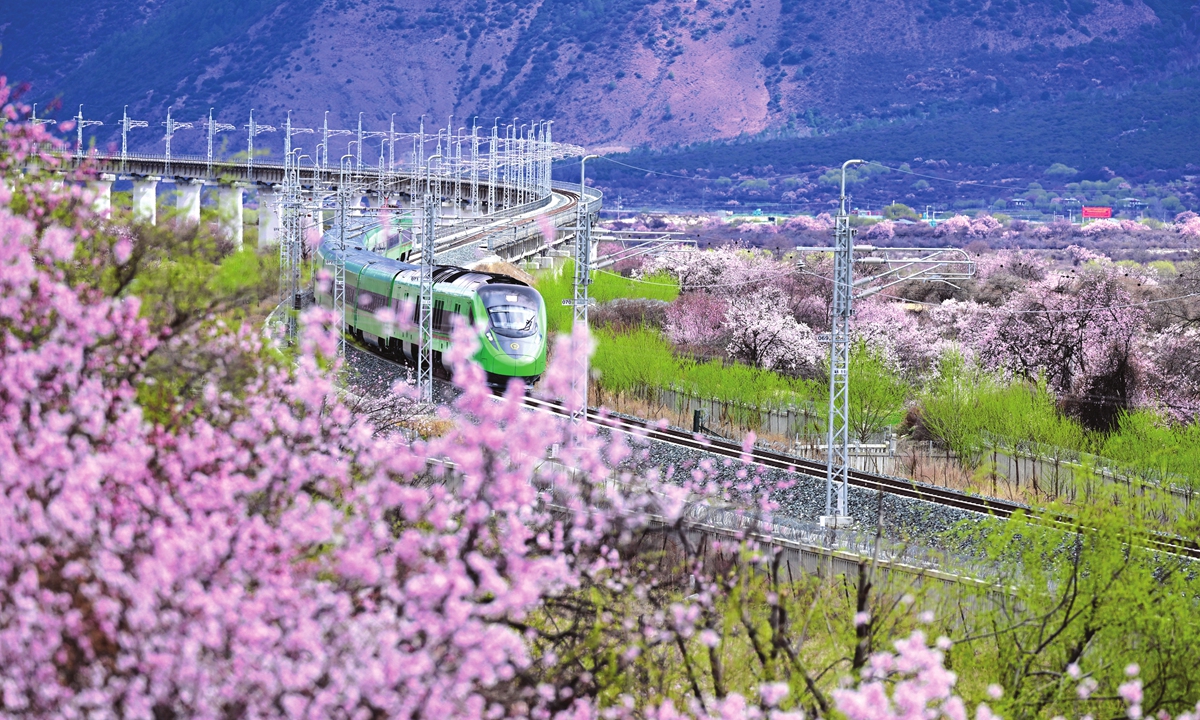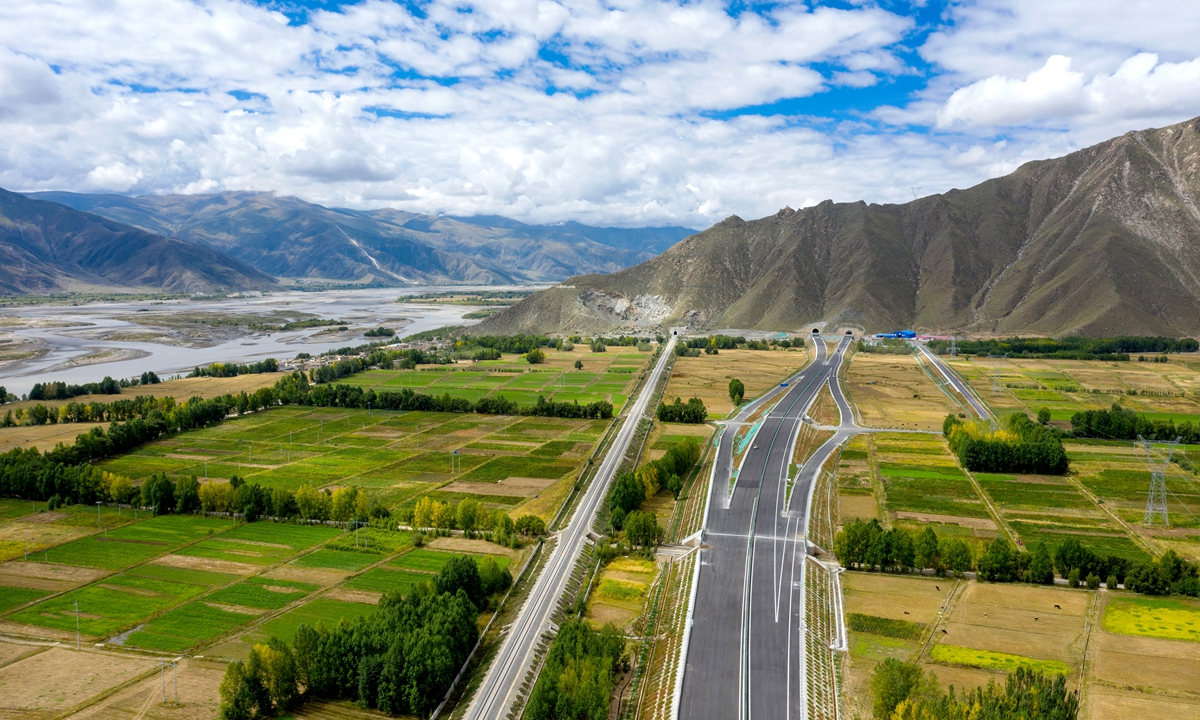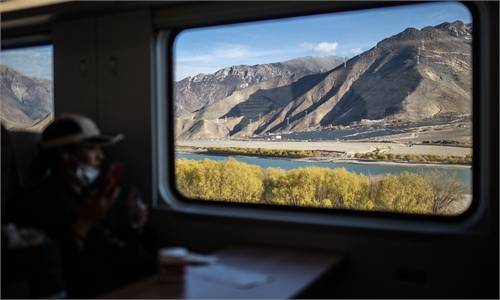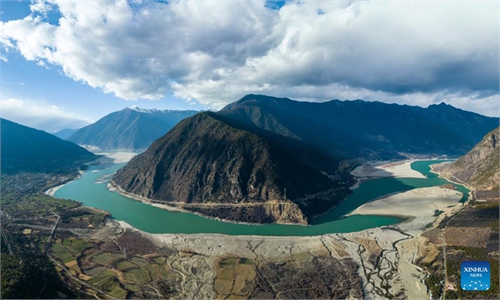IN-DEPTH / IN-DEPTH
Miracles on snowy plateau: Xizang moving forward fast to modernization with super projects despite harsh environment

Fuxing High-speed Train drives on the Lhasa-Nyingchi Railway on March 21, 2023, passing the pink sea of peach blossom in Bayi district, Nyingchi city of Southwest China's Xizang Autonomous Region. Photo: VCG
Editor's Note:
In his report to the 20th National Congress of the Communist Party of China (CPC), Xi Jinping, general secretary of the CPC Central Committee, proposed to comprehensively advance the great rejuvenation of the Chinese nation on all fronts through a Chinese path to modernization - a modernization of a huge population, of common prosperity for all, of material and cultural-ethical advancement, of harmony between humanity and nature, and of peaceful development.
For a long time, the Western perspective has dominated the narrative on modernization.
However, China's extraordinary achievements in all aspects demonstrate that there are alternative methods to modernization. The Chinese modernization is a new model for human advancement, and it dispels the myth that "modernization is equal to Westernization," presents another picture of modernization, expands the channels for developing countries to achieve modernization, and provides a Chinese solution to aid the exploration of a better social system for humanity.
Advancing Chinese modernization is a systematic endeavor and also an exploratory undertaking. It is through this framework that we wish to illustrate the process of the Chinese path to modernization through a series of landmark projects, touching stories and grand visions. This is the first installment.
In Southwest China's Xizang Autonomous Region, a network of roads, railways, and airports not only supports the well-being of the people living there but also guarantees the nation's security and regional stability.
Recently, Global Times reporters visited Xizang region to witness the miracle changes brought about by the high-altitude super projects in the region.
Building transportation infrastructure in the complex geological conditions of the snowy plateau is an unparalleled challenge. Thanks to the developed road network, countless Xizang residents have embarked on the road to prosperity, and the connection between the border region and inland cities has been fortified because of the convenience of transportation.
Harmonious interactions and exchanges have been established between people in Xizang region and other parts of China, creating a favorable social atmosphere for the modernization and development of Xizang. Xizang's development achievements are the result of the unity and the joint struggle of all ethnic groups in the region. The path to modernization in Xizang is one of the best interpretations of Chinese modernization practice.
In spring, Xizang's Nyingchi transforms into a wondrous sea of pink.
Wild peach blossoms spread from hills to fields, making the region a popular tourist destination in China.
While visiting the Galai village's peach blossom garden in Nyingchi, reporters from the Global Times saw large tourist groups fully enjoying the scenery by taking selfies, singing karaoke, enjoying local snacks, and integrating in traditional culture by wearing traditional Tibetan costumes.
The peach trees have also helped create a better life for villagers. Dawa Gyaltsen, a Galai villager, told the Global Times that his family of six receives more than 100,000 yuan ($14,000) from tourism cooperative dividends accrued by the village.
The improved transportation network has made such earnings possible.
"The National Highway 318 (G318) from Sichuan Province to Xizang region passes in front of our village. Moreover, now people can visit Nyingchi by plane and even by high-speed train," Dawa Gyaltsen said with bright smile.
Tourists from across the nation could visit the region by car, plane, or high-speed rail to appreciate the beautiful scenery of snow-capped mountains and pinky peach blossoms by the Yarlung Zangbo River.
On the C881 high-speed train from Lhasa to Nyingchi, a passenger from South China's Guangdong Province, surnamed Lu, told the Global Times that after landing in Xizang, he learned that a high-speed train route had been built and was operational between Lhasa and Nyingchi, so he bought a ticket to experience shuttling between snow-capped mountains and canyons.
Gao Na, the conductor of the train, told the Global Times that during the peak tourist season every year, the occupancy rate of the trains can reach 80 to 90 percent, and some tourists even make a special trip to experience the feeling of taking the Fuxing High-speed Train on the plateau. "I have met many tourists before. After taking the high-speed C881 train from Lhasa to Nyingchi, they only stopped for 20 minutes at the platform and then took train C882 from Nyingchi to Lhasa to return. This situation is something I have not encountered on other railway lines," Gao said.
At present, taking the high-speed railway can go directly from Nyingchi in southeastern Xizang to Shannan in southwestern Xizang.
In recent years, as Xizang's road network has continued to extend even further and the railway line continues to stretch into the hinterland, many of the original scenic spots on the plateau that were once inaccessible have now become popular scenic spots and the convenient transportation has attracted even more visitors from all over China and the world.
Hard-won achievements
In the last decade, Xizang has achieved multiple transportation miracles.
Located on the Qinghai-Xizang Plateau, Xizang features harsh climate conditions, complex and active geological structures, and a variety of disasters that occur frequently while suffering the effects of glaciers and frozen soil.
Despite these adverse natural geographical conditions, many Chinese engineering miracles have stunned people in the region. The Chengdu-Xizang Highway, located in the "world's second-largest debris flow group," has more than 300 geological disasters each year, and in many places, the road is only wide enough for one car to pass.
Its Tongmai section in Bomi county, Nyingchi is even known as the "death road" due to the dangers faced by road users.
In 2012, the construction and renovation project of the Tongmai section, with a total investment of nearly 1.5 billion yuan, officially began. After the project was completed and opened to traffic in 2016, the difficult problem of the "Tongmai obstruction" on the Chengdu-Xizang Highway was fundamentally solved.
Newly added protective nets, tunnels, and bridges have turned the dangerous terrain into a thoroughfare. The 14-kilometer-long Tongmai section has made history, and the total travel time for the entire route has been reduced from over 2 hours to just 20 minutes.
The Tongmai project, which turns danger into safety, is just a microcosm of the rapid development of transportation in Xizang region over the last decade.
In 2019, the world's highest-altitude special road tunnel, the Mila Mountain Tunnel, was completed, marking the full opening of the Lhasa-Nyingchi highway, which is about 400 kilometers long.
In August 2020, the National Highway 559 (G559) Gandeng section was officially opened to traffic, and the Xizang region officially achieved the goal of connecting all towns and villages by road.
In 2021, the world's highest-altitude highway, the Nagqu-Lhasa expressway, was fully opened to traffic, reducing travel time from Lhasa to Nagqu from over 6 hours to just 3 hours.
In 2022, Medog county, the last county in China to be connected by road, welcomed its second road, the Pai-Medog highway, which was fully completed, providing more reliable year-round access to Medog county.

The expressway linking Lhasa and Xigaze Photo: Courtesy of the Transportation Department of Xizang Autonomous Region
At the end of 2012, the total length of roads in Xizang was only 65,200 kilometers. A decade later, the total length of roads open to traffic in the region has reached 121,400 kilometers. The length of highways and expressways open to traffic in the entire region has increased from just 38 kilometers at the end of 2012 to the current 1,105 kilometers, and the three-hour comprehensive transportation circle centered on Lhasa is rapidly taking shape, the Global Times learned from Dawa Ouzhu, the Party Secretary and Deputy Director of the Xizang Regional Transportation Department.Moreover, as in the vast majority of Xizang region, rural roads remain the only means of transportation and the most direct and deep-reaching infrastructure linking farmers and herdsmen to the rest of the region. In recent years, the transportation department in the region has vigorously carried out construction on rural roads, closely combining the development of rural transportation with the strategy of rural revitalization and the improvement of people's livelihoods.
The length of rural roads in Xizang region increased from 53,200 kilometers at the end of 2012 to 90,400 kilometers in 2022, and their accessibility and smoothness have been greatly improved, the Global Times learned from the regional transportation department.
Map for future
Despite the achieved miracles, while on the Chinese path to modernization, Xizang region has more ambitious plans aimed at further connecting its people, lifting their livelihoods, and safeguarding border security.
Planning documents recently released by the Development and Reform Commission of the Xizang Autonomous Region also outlines the vision for the future of transportation in the region.
According to the documents, by 2035, general aviation in Xizang will achieve leapfrog development, with a total of 59 general airports in the region and several aprons built on demand. Each county-level administrative unit will basically have one or more general airports, and air services will cover more than 95 percent of the population in the region.
By 2025, the construction of the Sichuan-Xizang Railway section from Ya'an in Southwest China's Sichuan Province to Nyingchi will be smoothly implemented, along with the Xigaze-Peikucuo section of the Xinjiang-Xizang Railway, and the Bomi-Ranwu section of the Dali-Lhasa Railway.
The construction of the railway at Jilong port is also expected to be launched. The total scale of railways in the region, both built and under construction, will reach about 4,000 kilometers.
By 2035, the total scale of the railway network in Xizang will reach more than 5,000 kilometers, forming a modern railway network centered on Lhasa, covering all prefecture-level administrative regions in the region, and conveniently connecting adjacent provinces and autonomous regions such as Xinjiang, Qinghai, Sichuan, and Yunnan, as well as major land ports along the border.
These efforts are expected to support and lead the high-quality economic and social development of Xizang, as well as safeguard national security.
The road and railway network integrated into the backdrop of mountains and rivers is not only a beautiful eco-tourism route, but also a road to poverty alleviation and prosperity that promotes economic and social development in Xizang region.





